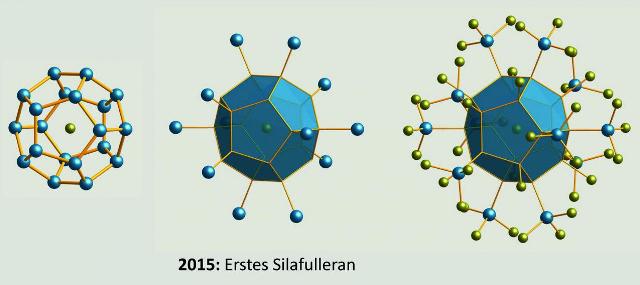Mar 19 2015
The discovery of the soccer ball-shaped C60 molecule in 1985 was a milestone for the development of nanotechnology. In parallel with the fast-blooming field of research into carbon fullerenes, researchers have spent a long time trying in vain to create structurally similar silicon cages.
 The Platonic solid, which was published in Angewandte Chemie, is not just aesthetically pleasing, it also opens up new perspectives for the semiconductor industry. Credit: Goethe University
The Platonic solid, which was published in Angewandte Chemie, is not just aesthetically pleasing, it also opens up new perspectives for the semiconductor industry. Credit: Goethe University
Goethe University chemists have now managed to synthesise a compound featuring an Si20 dodecahedron. The Platonic solid, which was published in the "Angewandte Chemie" journal, is not just aesthetically pleasing, it also opens up new perspectives for the semiconductor industry.
The Si20 dodecahedron is roughly as large as the C60 molecule. However, there are some crucial differences between the types of bonding: All of the carbon atoms in C60 have a coordination number of three and form double bonds. In the silicon dodecahedron, in contrast, all atoms have a coordination number of four and are connected through single bonds, so that the molecule is also related to dodecahedrane (C20H20). "In its day, dodecahedrane was viewed as the 'Mount Everest' of organic chemistry, because it initially could only be synthesized through a 23- step sequence. In contrast, our Si20 cage can be created in one step starting from Si2 building blocks," explains Prof. Matthias Wagner of the Goethe University Institute of Inorganic and Analytical Chemistry.
The Si20 hollow bodies, which have been isolated by his PhD student, Jan Tillmann, are always filled with a chloride ion. The Frankfurt chemists therefore suppose that the cage forms itself around the anion, which thus has a structure-determining effect. On its surface, the cluster carries eight chlorine atoms and twelve Cl3Si groups. These have highly symmetric arrangements in space, which is why the molecule is particularly beautiful. Quantum chemical calculations carried out by Professor Max C. Holthausen's research group at Goethe University show that the substitution pattern that was observed experimentally indeed produces a pronounced stabilisation of the Si20 structure.
In future, Tillmann and Wagner are planning to use the surface-bound Cl3Si anchor groups to produce three dimensional nanonetworks out of Si20 units. The researchers are particularly interested in the application potential of this new compound: "Spatially strictly limited silicon nanoparticles display fundamentally different properties to conventional silicon wafers," explains Matthias Wagner. The long strived-for access to siladodecahedrane thus opens up the possibility of studying the fundamental electronic properties of cage-like Si nanoparticles compared to crystalline semiconductor silicon.